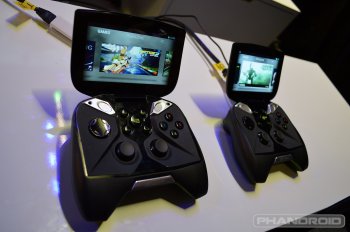
NVIDIA SHIELD price dropped to $299, release date set for June 27th! Are you buying? [POLL]
The NVIDIA SHIELD is quite the exciting device, one we’ve been waiting to see make its way to the forefront ever since NVIDIA let us in on the juicy project back at CES 2013 (read our initial hands-on impressions). We’d heard the company would be targeting a late June launch, and we’re happy to say that NVIDIA kept its promise — the company has confirmed that SHIELD’s release date is set for Thursday, June 27th!
The good news train doesn’t stop rolling there, though. NVIDIA has also settled on the final price for the device, as the device has been dropped to a cool $299. Many gamers expressed that $350 was just a bit too much, and that $299 would be a more attractive cost of admission.
Thankfully, NVIDIA took heed to that suggestion and gave gamers what they asked for. Fret not if you’ve already pre-ordered while the price was $350, as NVIDIA promises all existing pre-orders will only be charged the new $299 price once it’s shipped.
NVIDIA SHIELD vs PS Vita and Nintendo 3DS XL
To put the price into perspective, a PlayStation Vita WiFi costs $250, and that doesn’t include the cost of memory — $50 for a 16GB stick to match up with the SHIELD’s internal storage. Consider the fact that the Vita is based on ARM Cortex-A9 quad-core architecture and has a 5-inch touchscreen with a resolution of 960 x 544 (as well as a rather unique touchpad on the back).
The other big player in handheld, Nintendo, has its own interesting product. The Nintendo 3DS costs $170 for the base model and about $220 for an XL edition. This device has dual displays, with the bottom being touchscreen and the top being autostereoscopic 3D.
Processing power for the 3DS includes a dual-core ARM11 chipset with DMP’s single-core PICA200 graphics. Even going by the XL’s tale of the tape, the 3DS’ top display is 4.88 inches with 800 x 240 (400 x 240 for each eye when considering 3D mode) resolution, and 320 x 240 resolution on the smaller lower screen. Indeed, the 3DS is a unique experience, but it doesn’t quite come close to what the SHIELD (or the Vita, for that matter) can offer in terms of sheer performance.
So how, exactly, does the SHIELD stack up for $299? It’s slated to be the first Tegra 4-equipped device in the world, with the company’s latest quad-core ARM Cortex-A15 silicon (complete with a 72-core GeForce GPU) also coming with a 5-inch 720p HD display, and 2GB of RAM. Other specs of the SHIELD include WiFi 802.11n with 2×2 MIMO for streaming PC games, Bluetooth 3.0, GPS, Mini-HDMI, a microSD card slot, and a battery rated at 28.8 Wh. Of course, it also runs Android Jelly Bean for those of you who don’t know that our beloved operating system is running the show behind the beautiful SHIELD interface.
Don’t forget this clamshell form factor means there’s a full gamepad for you to get your game on with. The SHIELD’s gamepad includes dual analog sticks, dual shoulder buttons with accompanying triggers, a full suite of face buttons, a d-pad, standard Android navigation buttons for home and back, as well as a start button. Considering all of that, it seems like quite the value.
NVIDIA SHIELD vs WikiPad
NVIDIA’s SHIELD will also contend with the Wikipad, a gaming tablet that can be docked into a controller. This device, launched at the start of E3, is a 7-inch tablet for $250, and it’s fittingly powered by NVIDIA Tegra 3. That gives it a quad-core ARM Cortex-A9 chipset along with 1GB of RAM, 16GB of internal storage, a microSD card slot, HDMI, Bluetooth 4.0, WiFi, GPS, a 2 megapixel front camera and more.
The WikiPad’s flexibility as a full-fledged tablet might make it more valuable to some. It also has full access to the Google Play Store, as well as access to some of Sony’s titles as it’s part of the PlayStation Certified initiative. The unique controller dock features a nice mix of face buttons, a d-pad and dual analog sticks, and also has two triggers behind it (but no shoulder buttons / bumpers to go along with those).
Are you buying?
NVIDIA has been listening to the feedback since CES and beyond, and have since tweaked the device to make it more enjoyable to use. Triggers have inched around to make them more easy to use, the analog thumb sticks feel more solid, buttons give better feedback and the software is more responsive.
To top all of that off, the hinge mechanic for opening and closing the device has been made even sturdier than it already was, which should quell fears of it feeling loose after hundreds or even thousands of openings and closings. It should all come together to make for an experience even better than what our fond memories from CES are allowing us to remember.
With that, we’re curious — are you buying the SHIELD? It’s $50 cheaper than originally anticipated, and outclasses most of the competition with ease. With support for Tegra-optimized Android games and the forthcoming ability to stream PC games using WiFi 2×2 MIMO, this is one hot device that could change the face of mobile gaming as we know it.
If you’re not buying it, we want to know why. Is the form factor not appealing? Are you worried about the amount of third-party development support it’ll get down the line? Is it still a bit too rich for your wallet? Whatever your concerns are, be sure to let us know in the comments section below, and drop a quick vote in the poll while you’re at it! And if you’re sold, be sure to order yours at NVIDIA’s website.
[polldaddy poll=7191675]